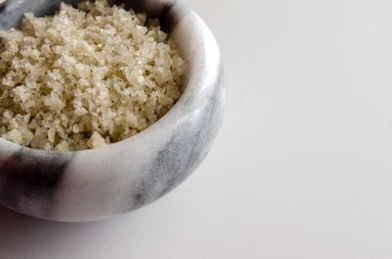
Related products
Tilapia, a common name for nearly a hundred species of cichlid fish predominantly found in freshwater habitats like ponds, rivers, and lakes, is one of the most highly consumed seafood items globally. This widely farmed variety of fish originated from regions within Africa, but its popularity has created an avenue for farming it across various geographical locations, including Asia and South America.
Widely recognized as a low-cost yet nutritious protein source well loaded with essential nutrients such as omega-3 fatty acids and vitamins B12 & D, along with minerals like selenium and magnesium, tilapia comes associated with several health benefits. Dr Jane Hart, a renowned nutritionist based in London, indicates that incorporating tilapia into diets supports brain function due to the presence of Omega 3 fats, which are pivotal for cognitive health. Likewise, for heart health, thanks to their ability to lower bad cholesterol levels, thus reducing risks tied to cardiovascular diseases.
On the flip side, there exist certain concerns over this seemingly harmless tableau painted about Tilapia consumption primarily revolving around their diet when farmed rather than wild-caught since they're often fed on unnatural feed containing harmful substances, which eventually affects human consumers negatively upon ingestion, leading to potential harmful accumulation toxins in our bodies over time resulting in serious implications down the line particularly concerning cancer threats or other related diseases.
Statistics provided by Marine Conservation Society UK reflect an annual procurement of approximately 55 thousand tonnes imported mainly via China (60%) followed closely behind Thailand, sharing the percentage pie at par having around close quarter contribution each towards yearly consumptions making Britain the world's largest importer thereby highlighting resident's fondness towards this particular variant amongst different available options out.
What Is Tilapia?

Tilapia encompasses a group of diverse, primarily freshwater fish from the Cichlidae family. Initially hailing from Africa but now ubiquitous across many distinct geographical locations due to extensive farming practices, tilapia has gained recognition as one of the most consumed seafood globally.
This popular variety of white fish is typically medium-sized with a deep body and long dorsal fin. Its mild-tasting meat adapts well to multiple cooking styles while offering lean protein at an affordable cost, making it a favorite among consumers far and wide.
Furthermore, their ability for fast growth combined with adaptability under densely populated environments makes these species particularly alluring choices within aquaculture business ventures around the globe, contributing dramatically towards increased production rates over time, leading to availability and helping in bridging scarcity gaps present amid demand-supply chains fulfilling ever-soaring global appetite craving more on nutritional fronts.
They are professionally appreciated by chefs worldwide because they easily absorb flavors used during culinary preparations, adding considerably towards enhancing taste profiles according to preference, still maintaining much-needed health benefits intact, providing essential nutrients including vitamins (B12 & D), Omega-3 fatty acids along with minerals like selenium magnesium directly influencing positively upon cognitive cardiovascular health.
Nutrient
The nutrient content in tilapia is quite remarkable. A serving of 100 grams of raw tilapia contains the following nutrients:
- Protein: High-quality protein is one of the key contributions, with about 20.08 grams present.
- Total Fat: Tilapia has a low-fat content - around 3.03 grams, including saturated and unsaturated fats.
- Carbohydrates: It's virtually carbohydrate-free with an approximate mere count of less than a gram at approximately 0.98 grams.
It does not end there; tilapia provides essential vitamins as well:
- Vitamin D: An estimated amount close to just about half a microgram helps maintain bone health
- Vitamin B12: Present in abundance, roughly calculated as much as two micrograms per serving supporting brain function.
- Important minerals are also part of this nutrition package:
- Selenium: Offering nearly fifty-four percent Daily Value (DV) at roundabout forty micrograms, critical for thyroid functions
- Magnesium: Containing some twenty-seven milligrams, helping numerous body processes
With all these beneficial attributes scientifically documented by reputable sources such as the United States Department of Agriculture(USDA), it becomes clear why many choose tilt towards including 'tilapia' in their daily dietary plans, providing comprehensive nutritional coverage aligning perfectly well overall well-being.
Benefits

Tilapia fish, a freshwater species found in warm climates worldwide, boasts an array of benefits for human health. Backed by scientific research and nutritional studies, these benefits include:
- Rich Source of Protein: A high-quality source like tilapia provides all the essential amino acids our bodies need to repair and build new cells, strengthen muscles, promote growth in children, and maintain cellular health.
- Reduces Risk Of Heart Disease: Omega-3 fatty acids are healthy fats known to reduce inflammation in blood vessels while decreasing harmful cholesterol (LDL) levels. These actions contribute significantly to maintaining heart health by preventing atherosclerosis, coronary artery disease, and heart attacks.
- Promotes Bone Health: Vitamin D is crucial in helping our bodies absorb and retain calcium, strengthening bones and teeth. Adequate amounts of vitamin D can help reduce the risk of bone-related diseases such as osteoporosis or rickets.
- Supports Weight Loss Efforts: The low-calorie count (96 calories per 100g serving) combined with its high-protein content acts to satiate hunger without adding excess fat or carbohydrates into your diet, hence supporting healthy weight loss efforts
- Excellent Source Of Vitamins And Minerals: Tilapia Fish has an impressive range of vitamins, especially B12, that ensures proper functionality of nerve cells; phosphorus promotes digestion efficiency while potassium helps regulate body fluid balance. Minerals magnesium and zinc, among others, strengthen the immune system, enhancing overall health
- Benefits Eye Health: Tilapias are replete with carotenoid antioxidants, including Zeaxanthin, lutein that shields eye tissues from oxidative stress damage, thus lowering risks of age-related macular degeneration, cataracts, boosting general visual acuity. The omega-3 fatty acid elements notably contribute to improving cognitive function by enhancing neural connectivity.
Furthermore, B vitamins like niacin and folic acid facilitate brain development maintenance
- Combats Cancer: A Scientifically proven research posted in the Journal Molecular Nutrition & Food Research highlighted how the selenium compound present inhibits the proliferation of cancer cells, hence offering a protective role against certain forms of cancers.
- Enhances Skin Health: The proteins give rise to building blocks essential for promoting healthier skin. This contributes to skin elasticity and firmness. Moreover, due to retention qualities, it assists in keeping dryness at bay, giving you a moisturized look and feel.
- Relieves Rheumatoid arthritis symptoms scientific study published by Arthritis Research Therapy pointed out that long-term dietary intake of fish tilapia is significantly linked to reduced rheumatoid arthritis activity, ensuring joint mobility flexibility.
Risks
While the benefits of Tilapia fish are noteworthy, it is fair to acknowledge the potential risks associated with its consumption.
Contains Dioxins: Dioxin-related compounds produced by industrial processes found in the common environment. They bioaccumulate, i.e., pile up living organisms over time. Upon regular consumption of dioxin-tainted foods such as farm-raised tilapia, a person is likely to suffer from reproductive developmental problems, damaged immune system, hormonal imbalances that interfere with hormones, and induce various types of cancers
High Amounts of Omega-6 Fatty Acids: The standard Western diet is already overly rich in omega-6. To maintain a healthy balance, it is recommended that the ratio be roughly one-to-one. Nonetheless, farm-bred tilapia possesses a skewed ratio favoring more Omega -leading chronic inflammation-a root cause of myriad health conditions ranging from heart disease to diabetes and arthritis too.
Risk Antibiotic Residues: There are practices in aquacultures that involve the usage of antibiotics growth hormones. This result traces these drugs accumulating tilapia tissues, thus when consumed by human beings, gives rise to antibiotic resistance-a global health problem diminishing the effectiveness of essential medicines.
Exposure to Heavy Metals: Any fish, including tilapia, that lives in polluted water, will likely ingest heavy metals, mercury lead. Long-term exposure to these toxic substances through diet instigates neurological problems and kidney damage, among other issues.
Poor Diets Farmed Tilapias: Farm-raised fishes are often given poor diets, corn, and soy, lacking varied nutrients. Thus, farmed tilapia is comparatively less nutritious and sometimes contains unhealthy fats, too.
Safe Way to Eat Tilapia
To safely reap the benefits of tilapia, consider these guidelines:
Opt for Wild-Caught Tilapia: Whenever available, choose wild-caught over farmed as it usually contains less contaminants and has a healthier balance of nutrients. Industrial farming practices expose tilapia to various risks like antibiotic residues, poor-quality diets and heavy metals. Sourcing wild-caught varieties circumnavigates possible drawbacks associated with farm- bought ones.
Cook Properly: Cooking fish properly ensures a delicious meal and a vital safety aspect. Undercooked pose a threat to bacterial infections, particularly vulnerable groups, e.g., pregnant women and elderly people with weakened immune systems. Ensure your fish is thoroughly cooked at an internal temperature of 145°F (63°C) for at least 15 seconds. This reduces the risk of foodborne illnesses.
Purchase credible sources: To ensure you're getting the highest quality product, buying fish from recognized, trusted vendors who adhere to stringent safety standards is important. It provides assurance you're avoiding potential health risks associated with low-grade aquaculture
Limit consumption and avoid monotony balanced diets comprising different proteins and seafood will provide a wide range of beneficial vitamins and minerals while mitigating the risk of excessive toxin accumulation through single-source foods. Consumers must strive for variety, mindful of their protein choices.
A Mindful preparation method or grilling is considered a healthier option than deep-frying; it helps retain original nutrient value besides moderating additional fat calorie intake, ensuring a wholesome, nutritious meal yet delightfully palatable.
Alternatives
When seeking alternatives to tilapia, consider the following options:
- Cod: Possesses similar texture and flavor to tilapia while providing high protein content and lower fat. Cod gives you a hearty serving of essential minerals such as potassium, sodium, and calcium, besides the critical amino acid taurine, like tilapia. Look out for wild-caught Atlantic Pacific versions since they tend to be less contaminated than farm-bred one.
- Halibut: is a more upscale choice with lean white meat that's rich in vitamins B6, B12, and vitamin D. With its firm yet tender white flesh and pleasantly mild flavor, Halibut makes a worthy alternative to tilapia. The fish is super nutritious and packed with selenium, potassium, and Omega 3 fats, too.
- Flounder: Flounders offer simple, delicate flavors alongside the nutritional bonus of ample amounts of phosphorus, niacin, and vitamins, making them the perfect pick for those seeking a lighter option seafood diet.
- Pollock: Popularly used surimi, aka imitation crab. Pollocks deliver many omega fats that benefit cardiovascular health and brain function. Additionally, they harbor decent levels of zinc copper, assisting metabolism and boosting immunity, respectively.
- Catfish: Typically milder, slightly sweeter compared to other fishes. Catfish bring table impressive nutrient balance, enabling overall well-being.
Therefore, if you're looking to switch up your regular seafood routine without compromising nutrition, cater these substitutes away.
Bottomline
Tilapia, a protein-rich fish, provides numerous health benefits, including heart and bone health support, enhanced cognitive function, eye protection, and potential anti-cancer properties. However, risks include dioxin contamination, imbalance of Omega fats, antibiotic residues, and heavy metal exposure in farmed versions. For safe consumption, opt for wild-caught tilapia from reputable sources where possible; ensure it's thoroughly cooked to minimize the risk of foodborne illnesses; maintain dietary diversity; and lean towards healthier cooking methods like baking or grilling.
Frequently Asked Questions
What are the disadvantages of eating tilapia fish?
Tilapia fish can be a disadvantage because they can potentially contain contaminants such as dioxins, heavy metals, and antibiotic residues in farmed versions. They also contain high amounts of omega-6 fatty acids, which might lead to inflammation when consumed in excess.
Is tilapia good or bad for you?
Tilapia presents both pros and cons for health. It is beneficial due to its protein content, omega-3 fatty acids, and vitamins that support heart, bone, and cognition, among other things. However, potential risks exist in consuming farmed varieties owing to contamination issues.
What are the bone benefits of tilapia fish?
Tilapia's bone benefits stem from its Vitamin D presence. It aids calcium absorption, hence promoting the strength of teeth and bones while lowering the risk of osteoporosis and rickets.
Why is the tilapia so important?
Tilapia's importance largely lies within its global dietary contribution. Being one of the most widely consumed fish world over signifies an integral role it plays in providing accessible, affordable sources of essential nutrients across populations
How to know if tilapia is bad?
To identify if tilapia has gone bad, look for color changes and texture smell. Rancid or off smells, the slimy surface upon touch, and faded color are clear spoilage indicators. Fish should be discarded to avoid food poisoning.
What is the best fish to eat?
Determining the best fish to eat depends on individual nutritional needs and preferences. Having said so, some universally recognized healthy options comprise salmon, mackerel, and tuna primarily because of their rich omega-three content and myriad overall health advantages.






















 Rated Excellent by 26,523+ Reviews
Rated Excellent by 26,523+ Reviews